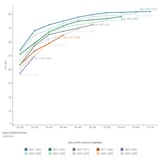Search Results
6/25/2025, 1:09:29 PM
>>508663453
>Recently, it was revealed that the membership ranks of the Liberal Party were plummeting, with one party source claiming that the biggest party expense at the local level was “funeral wreaths”.
>Twenty years ago, in Victoria, the Liberal Party had approximately 15,000 members. Today, more recent figures indicate that the state’s party membership stands at between 9,000 and 10,000 members.
>The average age of that membership? 68 years of age.
>Meanwhile, in New South Wales:
>The NSW Liberal party’s annual disclosures to the state electoral commission also show a significant drop in revenue from members.
>In 2018-19, the party generated $1.38m from “paid individuals” who had either a membership, an affiliation or a party subscription. That figure dropped to $836,770 last financial year, according to disclosures.
>Back in early May, it was confirmed by NSW Liberal Party officials that roughly 5,000 people had allowed their party membership to lapse. Some members of the party have blamed the decline on factional infighting within local branches of the NSW arm.
>While age demographics are certainly not the Liberal Party’s friend, the simple reality is they are increasingly detached from not only the foundational values of the party itself but also from the priorities of the broader electorate.
>To quote the conclusions of Sydney barrister and writer Gray Connolly:
>“There’s no future for conservatives if young people have nothing to conserve”.
>Once upon a time, the Liberal Party focused on attempting to ensure that every Australian had a stake in society to conserve, one based on homeownership.
>In reality, every generation of Australians since 1976 has seen worse and worse homeownership outcomes than those who came before them.
>It’s worth noting that the rates of home ownership are distorted somewhat higher by the impact of lower levels of household formation.
1/2
>Recently, it was revealed that the membership ranks of the Liberal Party were plummeting, with one party source claiming that the biggest party expense at the local level was “funeral wreaths”.
>Twenty years ago, in Victoria, the Liberal Party had approximately 15,000 members. Today, more recent figures indicate that the state’s party membership stands at between 9,000 and 10,000 members.
>The average age of that membership? 68 years of age.
>Meanwhile, in New South Wales:
>The NSW Liberal party’s annual disclosures to the state electoral commission also show a significant drop in revenue from members.
>In 2018-19, the party generated $1.38m from “paid individuals” who had either a membership, an affiliation or a party subscription. That figure dropped to $836,770 last financial year, according to disclosures.
>Back in early May, it was confirmed by NSW Liberal Party officials that roughly 5,000 people had allowed their party membership to lapse. Some members of the party have blamed the decline on factional infighting within local branches of the NSW arm.
>While age demographics are certainly not the Liberal Party’s friend, the simple reality is they are increasingly detached from not only the foundational values of the party itself but also from the priorities of the broader electorate.
>To quote the conclusions of Sydney barrister and writer Gray Connolly:
>“There’s no future for conservatives if young people have nothing to conserve”.
>Once upon a time, the Liberal Party focused on attempting to ensure that every Australian had a stake in society to conserve, one based on homeownership.
>In reality, every generation of Australians since 1976 has seen worse and worse homeownership outcomes than those who came before them.
>It’s worth noting that the rates of home ownership are distorted somewhat higher by the impact of lower levels of household formation.
1/2
Page 1
